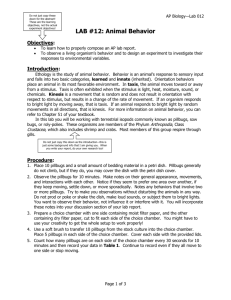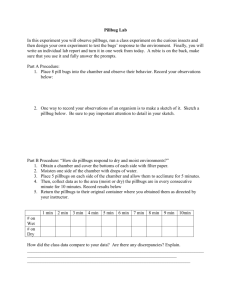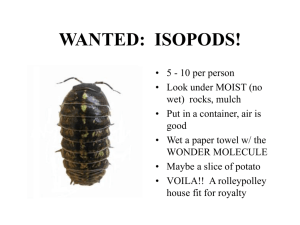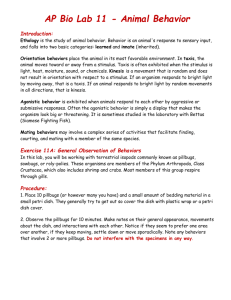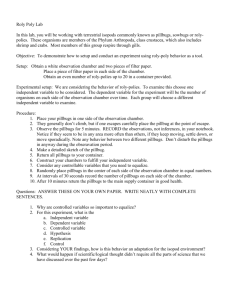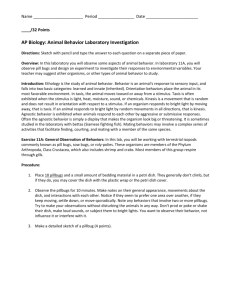Activity 3.2.1 Response to Environment
advertisement
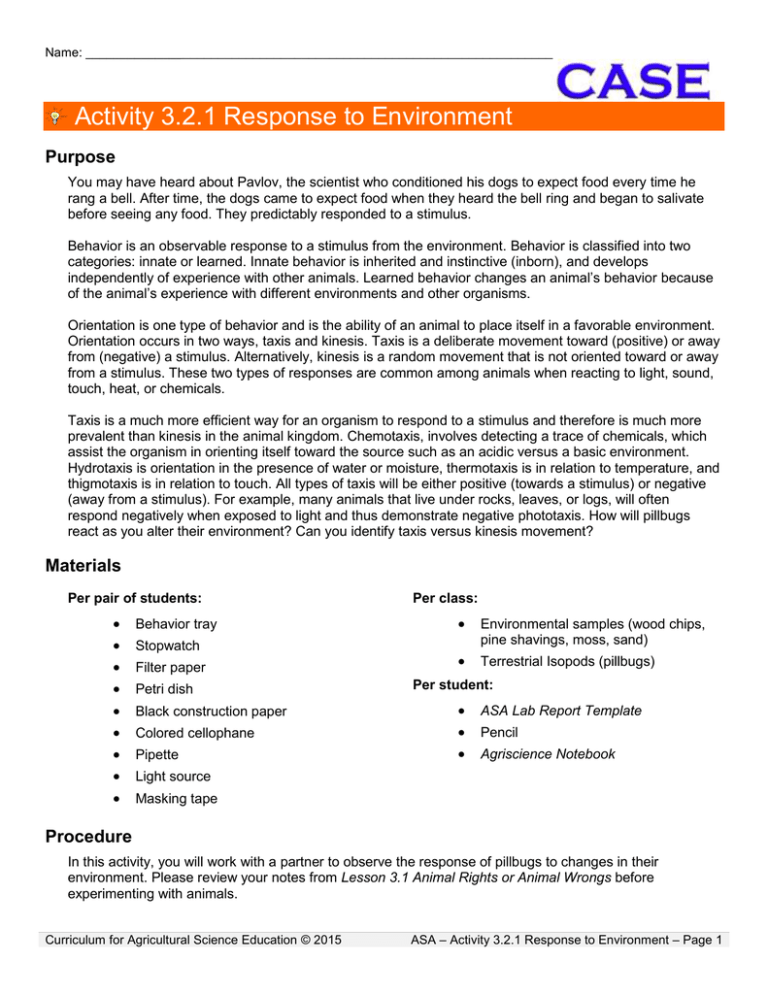
Name: ___________________________________________________________________ Activity 3.2.1 Response to Environment Purpose You may have heard about Pavlov, the scientist who conditioned his dogs to expect food every time he rang a bell. After time, the dogs came to expect food when they heard the bell ring and began to salivate before seeing any food. They predictably responded to a stimulus. Behavior is an observable response to a stimulus from the environment. Behavior is classified into two categories: innate or learned. Innate behavior is inherited and instinctive (inborn), and develops independently of experience with other animals. Learned behavior changes an animal’s behavior because of the animal’s experience with different environments and other organisms. Orientation is one type of behavior and is the ability of an animal to place itself in a favorable environment. Orientation occurs in two ways, taxis and kinesis. Taxis is a deliberate movement toward (positive) or away from (negative) a stimulus. Alternatively, kinesis is a random movement that is not oriented toward or away from a stimulus. These two types of responses are common among animals when reacting to light, sound, touch, heat, or chemicals. Taxis is a much more efficient way for an organism to respond to a stimulus and therefore is much more prevalent than kinesis in the animal kingdom. Chemotaxis, involves detecting a trace of chemicals, which assist the organism in orienting itself toward the source such as an acidic versus a basic environment. Hydrotaxis is orientation in the presence of water or moisture, thermotaxis is in relation to temperature, and thigmotaxis is in relation to touch. All types of taxis will be either positive (towards a stimulus) or negative (away from a stimulus). For example, many animals that live under rocks, leaves, or logs, will often respond negatively when exposed to light and thus demonstrate negative phototaxis. How will pillbugs react as you alter their environment? Can you identify taxis versus kinesis movement? Materials Per pair of students: Behavior tray Stopwatch Filter paper Petri dish Black construction paper Colored cellophane Pipette Per class: Environmental samples (wood chips, pine shavings, moss, sand) Terrestrial Isopods (pillbugs) Per student: ASA Lab Report Template Pencil Agriscience Notebook Light source Masking tape Procedure In this activity, you will work with a partner to observe the response of pillbugs to changes in their environment. Please review your notes from Lesson 3.1 Animal Rights or Animal Wrongs before experimenting with animals. Curriculum for Agricultural Science Education © 2015 ASA – Activity 3.2.1 Response to Environment – Page 1 Part One – Initial Pillbug Observation 1. Place several pillbugs in the behavior tray and carefully observe them for 4 minutes. 2. In Table 1 on Activity 3.2.1 Student Worksheet, document any behaviors you observe. Document all behaviors observed in chronological order. Note: Do not disturb the pillbugs; shaking or tipping the tray will cause unnatural behavior in the pillbugs. Part Two – Pillbug Movement 1. Place a small piece of masking tape on each side of the behavior tray and label one side A and the other side B. 2. Place five pillbugs in each side of the behavior tray. 3. Every minute for 10 minutes, count the number of pillbugs in each side. 4. Record your observations in Table 2 on Activity 3.2.1 Student Worksheet. 5. Calculate the average number of pillbugs in each chamber for the 10-minute time period. Enter the results in Table 2. 6. Share your results as instructed by your teacher. 7. Calculate the class average for the number of pillbugs in each chamber in a 10-minute time period. Enter the results in Table 2. Part Three – Altering the Conditions You and your partner will design an experiment altering environmental conditions in the behavior tray to test the possible environmental factors that may affect pillbug behavior. 1. Select the environmental condition you and your partner would like to alter. 2. Use the Lab Report Template to record your hypothesis, materials, and procedures. 3. Form a hypothesis predicting how the pillbugs may react to the environment you are testing. 4. Using the materials listed above; design an experiment to test the condition you will be altering. 5. Obtain approval from your teacher before proceeding. Conduct the experiment and collect your data. 6. Using the grids on page 5 of Activity 3.2.1 Student Worksheet, draw a graph of your data from Part Two and Part Three. Examine your graph and based on your findings, write a conclusion. It is recommended that you include your graph in your report. Conclusion 1. In Part Two, you placed equal numbers of pillbugs in each chamber of a behavior tray and collected data. What purpose do you think this served? 2. Based on your experimental design in Part Three, which environment did the pillbug prefer? How do you think this preference benefits the organism in its natural environment? 3. Did the pillbugs respond to stimuli? If so, how? 4. Justify your answer to Conclusion question 3 Curriculum for Agricultural Science Education © 2015 ASA – Activity 3.2.1 Response to Environment – Page 2 Name: ___________________________________________________________________ Activity 3.2.1 Student Worksheet Table 1. General Observations Table2. Pillbug Movement Time (min) # Pillbugs in Side A # Pillbugs in Side B 0 1 2 3 4 5 6 7 8 9 10 Average Class average Curriculum for Agricultural Science Education © 2015 ASA – Activity 3.2.1 Response to Environment – Page 3 Graphs Curriculum for Agricultural Science Education © 2015 ASA – Activity 3.2.1 Response to Environment – Page 4

